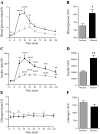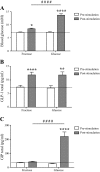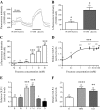Fructose stimulates GLP-1 but not GIP secretion in mice, rats, and humans
- PMID: 24525020
- PMCID: PMC3962593
- DOI: 10.1152/ajpgi.00372.2013
Fructose stimulates GLP-1 but not GIP secretion in mice, rats, and humans
Abstract
Nutrients often stimulate gut hormone secretion, but the effects of fructose are incompletely understood. We studied the effects of fructose on a number of gut hormones with particular focus on glucagon-like peptide 1 (GLP-1) and glucose-dependent insulinotropic polypeptide (GIP). In healthy humans, fructose intake caused a rise in blood glucose and plasma insulin and GLP-1, albeit to a lower degree than isocaloric glucose. Cholecystokinin secretion was stimulated similarly by both carbohydrates, but neither peptide YY3-36 nor glucagon secretion was affected by either treatment. Remarkably, while glucose potently stimulated GIP release, fructose was without effect. Similar patterns were found in the mouse and rat, with both fructose and glucose stimulating GLP-1 secretion, whereas only glucose caused GIP secretion. In GLUTag cells, a murine cell line used as model for L cells, fructose was metabolized and stimulated GLP-1 secretion dose-dependently (EC50 = 0.155 mM) by ATP-sensitive potassium channel closure and cell depolarization. Because fructose elicits GLP-1 secretion without simultaneous release of glucagonotropic GIP, the pathways underlying fructose-stimulated GLP-1 release might be useful targets for type 2 diabetes mellitus and obesity drug development.
Keywords: enteroendocrine axis; gastric inhibitory peptide; glucagon-like peptide-1.
Figures





Similar articles
-
Carbohydrate-induced secretion of glucose-dependent insulinotropic polypeptide and glucagon-like peptide-1.J Diabetes Investig. 2016 Apr;7 Suppl 1(Suppl 1):27-32. doi: 10.1111/jdi.12449. Epub 2016 Mar 14. J Diabetes Investig. 2016. PMID: 27186352 Free PMC article. Review.
-
Canagliflozin potentiates GLP-1 secretion and lowers the peak of GIP secretion in rats fed a high-fat high-sucrose diet.Biochem Biophys Res Commun. 2017 Oct 14;492(2):161-165. doi: 10.1016/j.bbrc.2017.08.031. Epub 2017 Aug 10. Biochem Biophys Res Commun. 2017. PMID: 28803984
-
Mixed Meal and Intravenous L-Arginine Tests Both Stimulate Incretin Release Across Glucose Tolerance in Man: Lack of Correlation with β Cell Function.Metab Syndr Relat Disord. 2018 Oct;16(8):406-415. doi: 10.1089/met.2018.0022. Epub 2018 Aug 17. Metab Syndr Relat Disord. 2018. PMID: 30117761 Free PMC article.
-
The 2-monoacylglycerol moiety of dietary fat appears to be responsible for the fat-induced release of GLP-1 in humans.Am J Clin Nutr. 2015 Sep;102(3):548-55. doi: 10.3945/ajcn.115.106799. Epub 2015 Jul 15. Am J Clin Nutr. 2015. PMID: 26178726 Clinical Trial.
-
Glucose-dependent insulinotropic polypeptide: effects on insulin and glucagon secretion in humans.Dan Med J. 2016 Apr;63(4):B5230. Dan Med J. 2016. PMID: 27034187 Review.
Cited by
-
Circulating fructose regulates a germline stem cell increase via gustatory receptor-mediated gut hormone secretion in mated Drosophila.Sci Adv. 2023 Feb 24;9(8):eadd5551. doi: 10.1126/sciadv.add5551. Epub 2023 Feb 24. Sci Adv. 2023. PMID: 36827377 Free PMC article.
-
The Contribution of Dietary Fructose to Non-alcoholic Fatty Liver Disease.Front Pharmacol. 2021 Nov 18;12:783393. doi: 10.3389/fphar.2021.783393. eCollection 2021. Front Pharmacol. 2021. PMID: 34867414 Free PMC article. Review.
-
Duodenal luminal nutrient sensing.Curr Opin Pharmacol. 2014 Dec;19:67-75. doi: 10.1016/j.coph.2014.07.010. Epub 2014 Aug 9. Curr Opin Pharmacol. 2014. PMID: 25113991 Free PMC article. Review.
-
Effects of high-fat diet and fructose-rich diet on obesity, dyslipidemia and hyperglycemia in the WBN/Kob-Leprfa rat, a new model of type 2 diabetes mellitus.J Vet Med Sci. 2017 Jun 10;79(6):988-991. doi: 10.1292/jvms.17-0136. Epub 2017 Apr 21. J Vet Med Sci. 2017. PMID: 28442647 Free PMC article.
-
Fructose induces glucose-dependent insulinotropic polypeptide, glucagon-like peptide-1 and insulin secretion: Role of adenosine triphosphate-sensitive K(+) channels.J Diabetes Investig. 2015 Sep;6(5):522-6. doi: 10.1111/jdi.12356. Epub 2015 May 3. J Diabetes Investig. 2015. PMID: 26417408 Free PMC article.
References
-
- Bismut H, Hers HG, Van Schaftingen E. Conversion of fructose to glucose in the rabbit small intestine. A reappraisal of the direct pathway. Eur J Biochem 213: 721–726, 1993 - PubMed
-
- Bray GA. How bad is fructose? Am J Clin Nutr 86: 895–896, 2007 - PubMed
-
- Curry DL. Effects of mannose and fructose on the synthesis and secretion of insulin. Pancreas 4: 2–9, 1989 - PubMed
-
- Drucker DJ, Jin T, Asa SL, Young TA, Brubaker PL. Activation of proglucagon gene transcription by protein kinase-A in a novel mouse enteroendocrine cell line. Mol Endocrinol 8: 1646–1655, 1994 - PubMed
Publication types
MeSH terms
Substances
Grants and funding
LinkOut - more resources
Full Text Sources
Other Literature Sources
Medical

